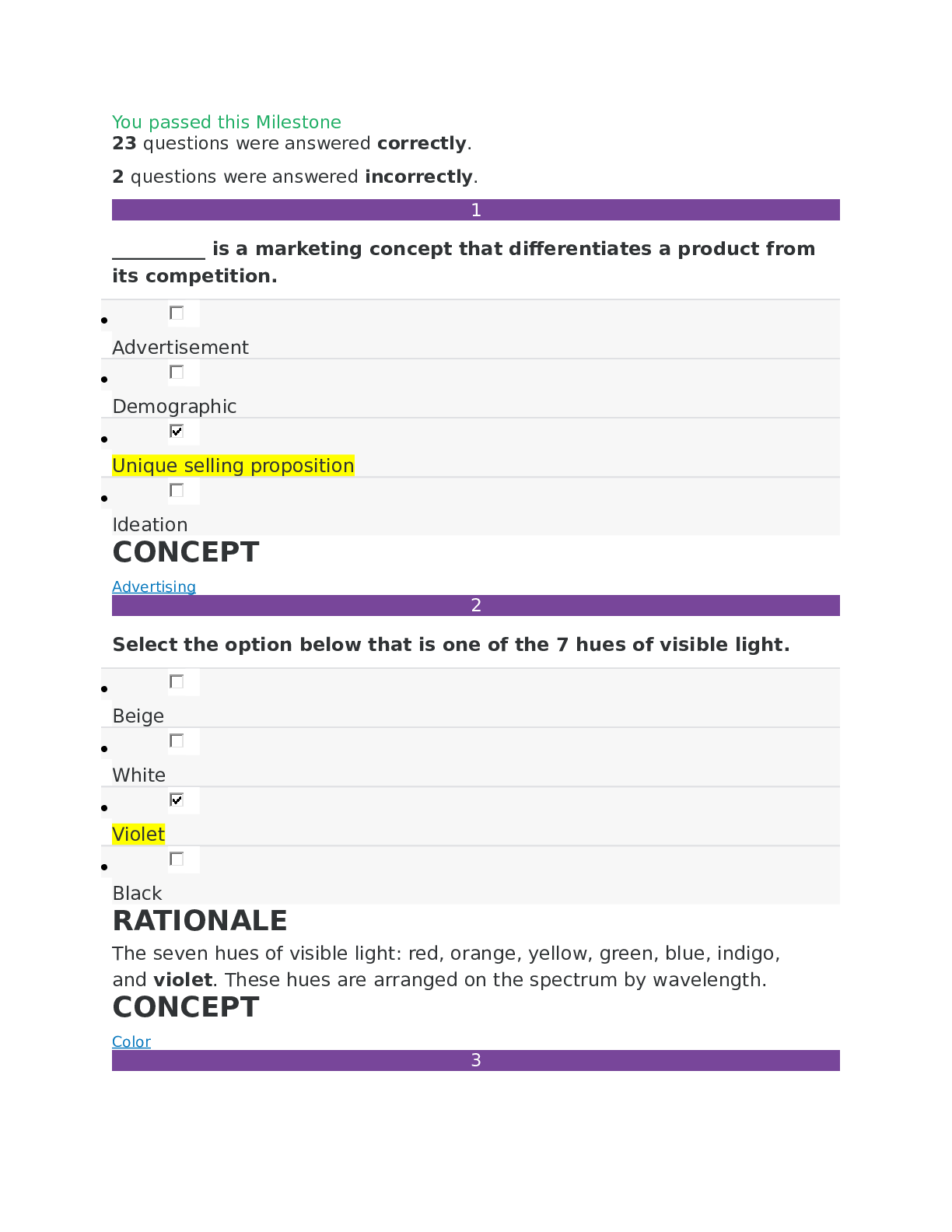Statistics > SOPHIA PATHWAY > MATH 1280 Milestone 4_Introduction to Statistics (2020) – University of the People | MATH1280 Mile (All)
MATH 1280 Milestone 4_Introduction to Statistics (2020) – University of the People | MATH1280 Milestone 4_Introduction to Statistics (2020)
Document Content and Description Below
1 MATH 1280 Milestone 4_Introduction to Statistics (2020) – University of the People Which statement about correlation is FALSE? • The correlation of a data set can be positive, neg... ative, or 0. • Correlation between the variables of the data set can be measured. • Correlation is the degree to which the two variables of a data set resemble each other. • Correlation is used to define the variables of only non-linearly related data sets. RATIONALE Recall that correlation is used for linear association between 2 quantitative variables, NOT for non-linearly related variables. CONCEPT Correlation 2 Which of the following statements is TRUE? • Only a correlation of 0 implies causation. • High correlation always implies causation. • High correlation does not always imply causation. • Only a correlation of 1 implies causation. RATIONALE Recall that correlation doesn't imply causation. Causation is a direct change in one variable causing a change in some outcome. Correlation is simply a measure of association. It is required for causation, but alone does not mean something is causal. CONCEPT Correlation and Causation 3 Shawna reads a scatterplot that displays the relationship between the number of cars owned per household and the average number of citizens who have health insurance in neighborhoods across the country. The plot shows a strong positive correlation. Shawna recalls that correlation does not imply causation. In this example, Shawna sees that increasing the number of cars per household would not cause members of her community to purchase health insurance. Identify the lurking variable that is causing an increase in both the number of cars owned and the average number of citizens with health insurance. • The number of cars on the road • Average mileage per vehicle • Average income per household • The number of citizens in the United States RATIONALE Recall that a lurking variable is something that must be related to the outcome and explanatory variable that when considered can help explain a relationship between 2 variables. Since higher income is positively related to owning more cars and having health insurance, this variable would help explain why we see this association. CONCEPT Correlation and Causation 4 Which of the following scatterplots shows an outlier in both the x- and y-direction? • RATIONALE To have an outlier in the x-direction and y-direction the outlier must be outside of the range of y data and outside the range of x-data. This outlier is below in the y-direction and to the left in the x-direction. CONCEPT Outliers and Influential Points 5 Which of the following scatterplots shows a correlation affected by inappropriate grouping? RATIONALE Since this data has 4 distinct groups, by examining overall correlation by all the data, it will not capture how the data in each group is associated. So overall the correlation might not be very strong, but if we look at correlation inside each group, there would be a much stronger relationship. CONCEPT Cautions about Correlation 6 Shawna finds a study of American women that had an equation to predict weight (in pounds) from height (in inches): ŷ = -260 + 6.6x. Shawna’s height was 64 inches and her weight was 150 pounds. What is the value of the residual for Shawna's weight and height? • -12.4 pounds • 12.4 pounds • 730 pounds • 162.4 pounds RATIONALE Recall that to get the residual, we take the actual value - predicted value. So if the actual height of 64 inches and the resulting actual weight is 150 pounds, we simply need the predicted weight. Using the regression line, we can say: The predicted weight is 164.4 pounds. So the residual is: CONCEPT Residuals 7 Raoul lives in Minneapolis and he is planning his spring break trip. He creates the scatterplot below to assess how much his trip will cost. Which answer choice correctly indicates the explanatory and response variables for the scatterplot? • Explanatory variable: Distance Response variable: Cost • Explanatory variable: Cost Response variable: Distance • Explanatory variable: Minneapolis Response variable: Miles flown • Explanatory variable: Miles flown Response variable: Minneapolis RATIONALE The explanatory variable is what is along the horizontal axis, which is distance. The response variable is along the vertical axis, which is cost. CONCEPT Explanatory and Response Variables 8 This scatterplot shows the performance of a thermocouple using the variables temperature difference and voltage. Select the answer choice that accurately describes the data's form, direction, and strength in the scatterplot. • Form: The data pattern is nonlinear. Direction: There is a negative association between temperature difference and voltage. Strength: The data pattern is weak. • Form: The data pattern is linear. Direction: There is a negative association between temperature difference and voltage. Strength: The data pattern is strong. • Form: The data pattern is nonlinear. Direction: There is a positive association between temperature difference and voltage. Strength: The data pattern is weak. • Form: The data pattern is linear. Direction: There is a positive association between temperature difference and voltage. Strength: The data pattern is strong. RATIONALE If we look at the data, it looks as if a straight line captures the relationship, so the form is linear. The slope of the line is positive, so it is increasing. Finally, since the dots are closely huddled around each other in a linear fashion, it looks strong. CONCEPT Describing Scatterplots 9 Jesse takes two data points from the weight and feed cost data set to calculate a slope, or average rate of change. A hamster weighs half a pound and costs $2 per week to feed, while a Labrador Retriever weighs 62.5 pounds and costs $10 per week to feed. Using weight as the explanatory variable, what is the slope of a line between these two points? Answer choices are rounded to the nearest hundredth. • $6.25 / lb. • $0.13 / lb. • $7.75 / lb. • $4.00 / lb. RATIONALE In order to get slope, we can use the formula: . Using the information provided, the two points are: (0.5 lb., $2) and (62.5 lb., $10). We can note that: CONCEPT Linear Equation Algebra Review 10 The scatterplot below shows the relationship between the grams of fat and total calories in different food items. The equation for the least-squares regression line to this data set is . What is the predicted number of total calories for a food item that contains 25 grams of fat? • 383.55 • 549.54 • 417.56 • 483.55 RATIONALE In order to get the predicted calories when the grams of fat is equal to 25, we simply substitute the value 25 in our equation for x. So we can note that: CONCEPT Predictions from Best-Fit Lines 11 Peter analyzed a set of data with explanatory and response variables x and y. He concluded the mean and standard deviation for x as 7.8 and 3.70, respectively. He also concluded the mean and standard deviation for y as 12.2 and 4.15, respectively. The correlation was found to be 0.964. Select the correct slope and y-intercept for the least-squares line. Answer choices are rounded to the hundredths place. • Slope = 1.08 y-intercept = -3.78 • Slope = 1.08 y-intercept = 3.78 • Slope = -1.08 y-intercept = -3.78 • Slope = -1.08 y-intercept = 3.78 RATIONALE We first want to get the slope. We can use the formula: To then get the intercept, we can solve for the y-intercept by using the following formula: We know the slope, , and we can use the mean of x and the mean of y for the variables and to solve for the y-intercept, . CONCEPT Finding the Least-Squares Line 12 Thomas was interested in learning more about the salary of a teacher. He believed as a teacher increases in age, the annual earnings also increases. The age (in years) is plotted against the earnings (in dollars) as shown below. Using the best-fit line, approximately how much money would a 45-year-old teacher make? • $48,000 • $55,000 • $58,000 • $50,000 RATIONALE To get a rough estimate of the salary of a 45 year-old, we go to the value of 45 on the horizontal axis and then see where it falls on the best-fit line. This looks to be about $50,000. CONCEPT Best-Fit Line and Regression Line 13 Data for weight (in pounds) and age (in months) of babies is entered into a statistics software package and results in a regression equation of ŷ = 17 + 0.8x. What is the correct interpretation of the slope if the weight is the response variable and the age is the explanatory variable? • The weight of a baby decreases by 0.8 pounds, on average, when the baby's age increases by 1 month. • The weight of a baby increases by 17 pounds, on average, when the baby's age increases by 1 month. • The weight of a baby decreases by 17 pounds, on average, when the baby's age increases by 1 month. • The weight of a baby increases by 0.8 pounds, on average, when the baby's age increases by 1 month. RATIONALE When interpreting the linear slope we generally substitute in a value of 1. So we can note that, in general, as x increases by 1 unit the slope tells us how the outcome changes. So for this equation we can note as x (age) increases by 1 month, the outcome (weight) will increase by 0.8 pounds on average. CONCEPT Interpreting Intercept and Slope 14 For the plot below the value of r2 is 0.7783. Which of the following sets of statements is true? • About 22% of the variation in ticket price can be explained by the distance flown. The correlation coefficient, r, is 0.606. • About 78% of the variation in ticket price can be explained by the distance flown. The correlation coefficient, r, is 0.882. • About 88% of the variation in ticket price can be explained by the distance flown. The correlation coefficient, r, is 0.882. • About 78% of the variation in distance flown can be explained by the ticket price. The correlation coefficient, r, is 0.606. RATIONALE The coefficient of determination measures the percent of variation in the outcome, y, explained by the regression. So a value of 0.7783 tells us the regression with distance, x, can explain about 77.8% of the variation in cost, y. We can also note that r = . CONCEPT Coefficient of Determination/r^2 15 Which of the following is a guideline for establishing causality? • Do not consider other possible causes. • Keep all variables the same to get duplicate results. • Check if the effect is present or absent when the response variable is present or absent. • Look for cases where correlation exists between the variables of a scatterplot. RATIONALE Recall that correlation is not sufficient alone to assess causality, however it is necessary. So for something to be causal, it must have a strong association. CONCEPT Establishing Causality 16 A correlation coefficient between number of miles driven and number of gallons of gas remaining is most likely to be __________. • between 0 and -1 • between -1 and -2 • between 1 and 2 • between 0 and 1 RATIONALE As the number of miles increases more gas is required, so there should be less gas in the tank. This would be a negative relationship and we would expect the value to be between 0 and -1. CONCEPT Positive and Negative Correlations 17 Rhonda is wondering if there is an association between the number of hours she studies per week and the number of semester credits she is enrolled in. The information is shown in the table below. If Rhonda is taking four credits for the fall semester, how many hours per week will she study? • 8 • 2 • 5 • 4 RATIONALE If we use the scatterplot and note the value above 4 credit hours on the horizontal axis, we find this value is also 4 on the vertical axis. She should expect to study 4 hours. CONCEPT Scatterplot 18 The scores of the quizzes of five students in both English and Science are: English Science Student 1 6 8 Student 2 5 5 Student 3 9 6 Student 4 4 7 Student 5 8 9 For English, the mean is 6.4 and the standard deviation is 2.0. For Science, the mean is 7 and the standard deviation is 1.6. Using the formula below or Excel, find the correlation coefficient, r, for this set of scores. Answer choices are rounded to the nearest hundredth. • 0.05 • 0.50 • 0.23 • 0.42 RATIONALE In order to get the correlation, we can use the formula: Correlation can be quickly calculated by using Excel. Enter the values and use the function "=CORREL(". CONCEPT Correlation [Show More]
Last updated: 1 year ago
Preview 1 out of 21 pages
 – University of the People.png)
Reviews( 0 )
Document information
Connected school, study & course
About the document
Uploaded On
Sep 14, 2020
Number of pages
21
Written in
Additional information
This document has been written for:
Uploaded
Sep 14, 2020
Downloads
0
Views
71


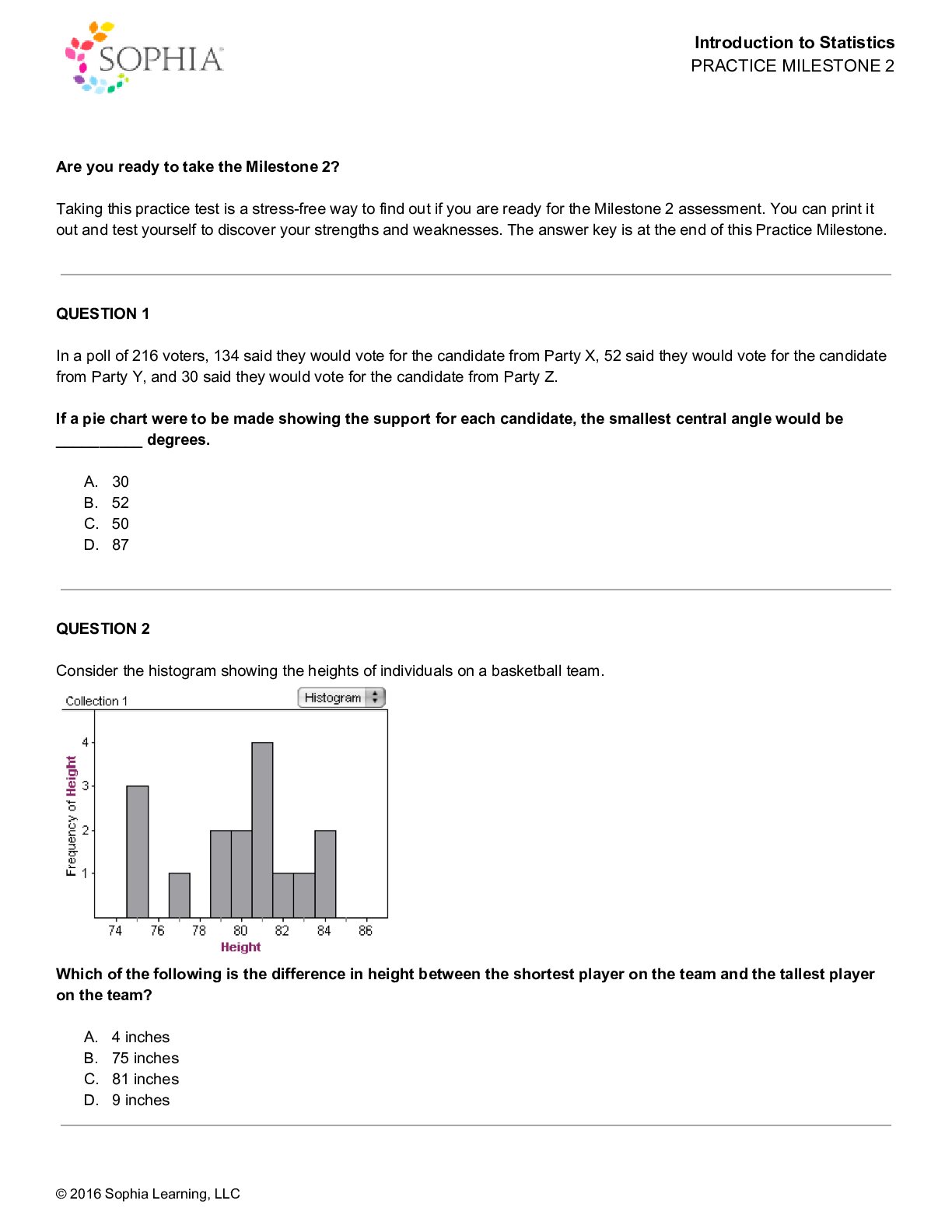
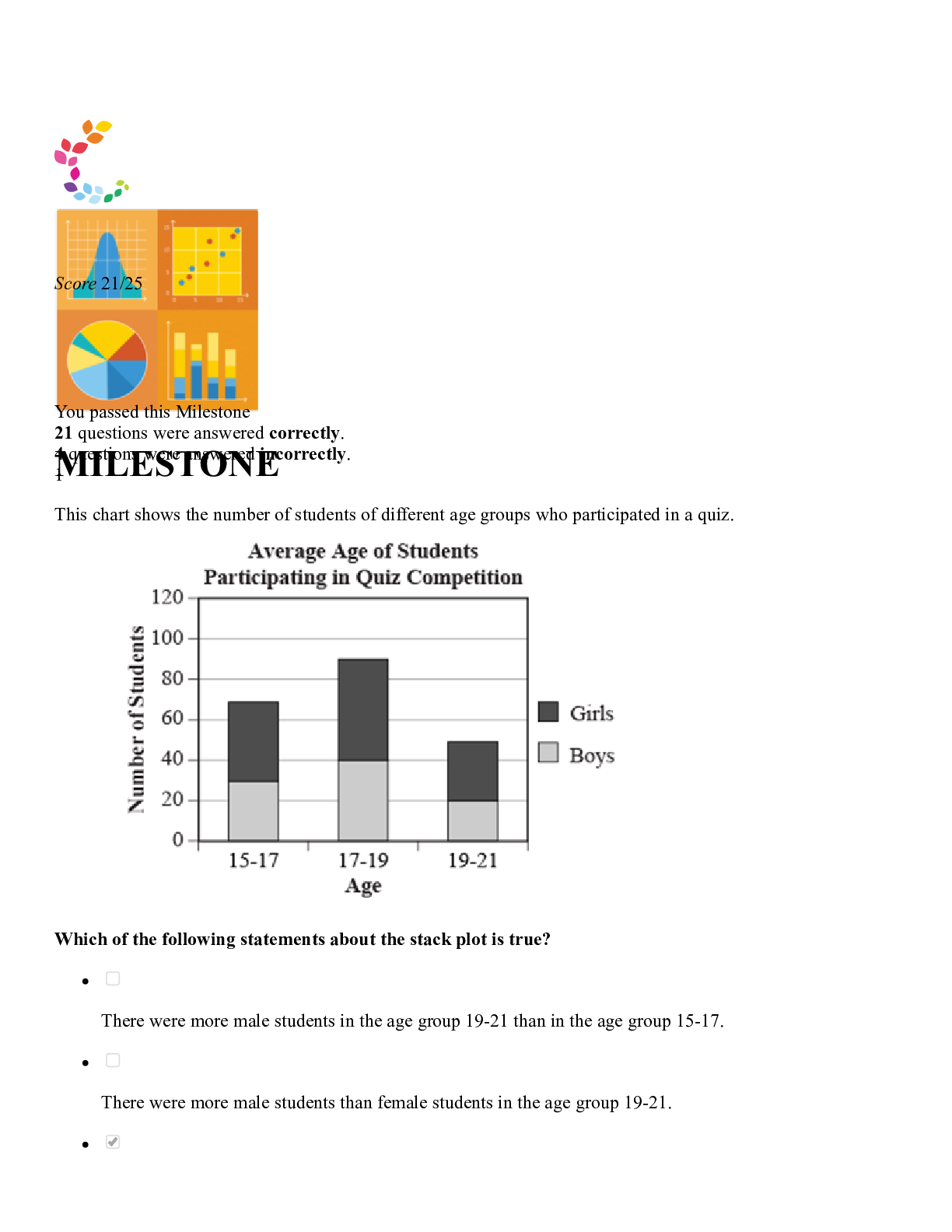

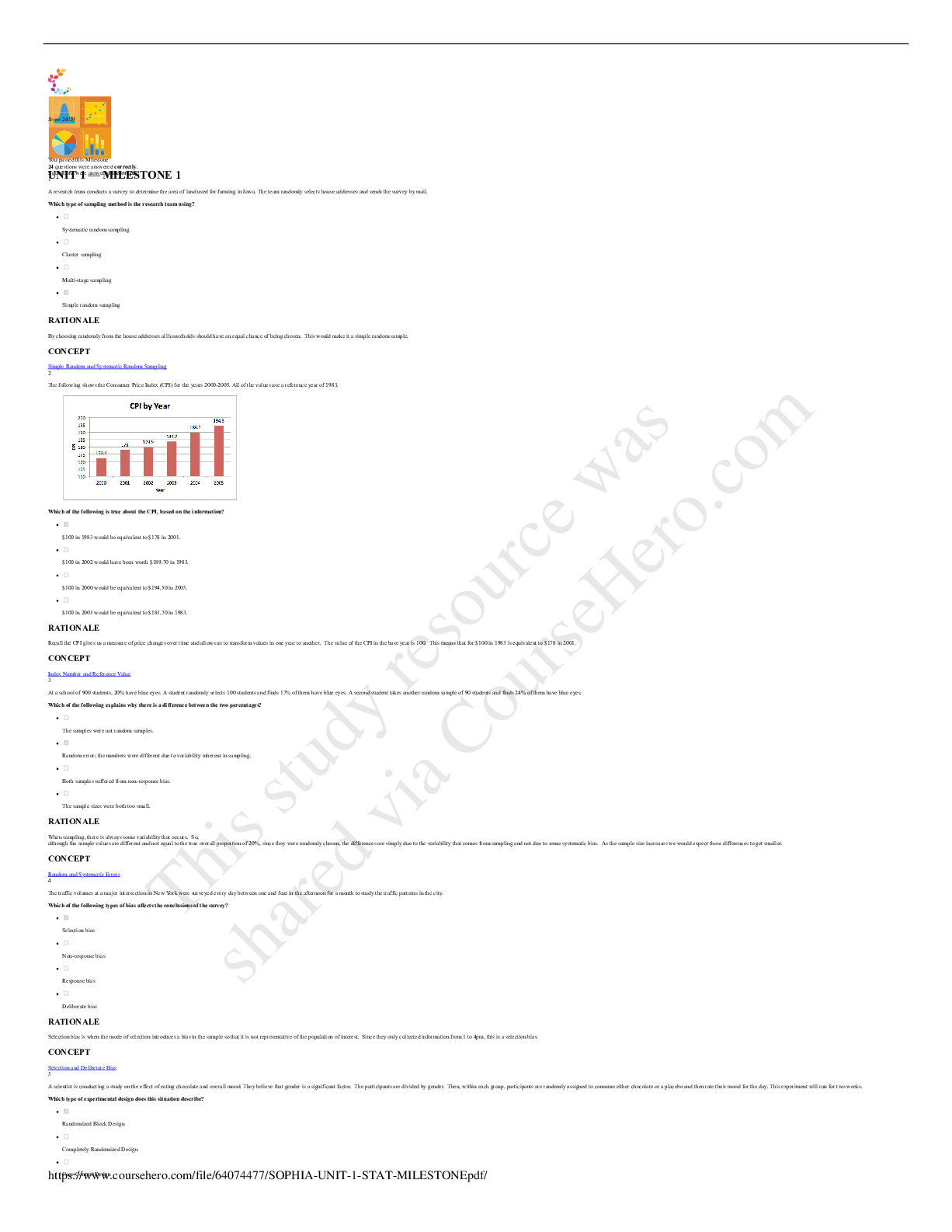
 – University of the People.png)

 – University of Maryland.png)
 – University of the People.png)
 – University of the People.png)
 – University of the People.png)
 – University of the people.png)
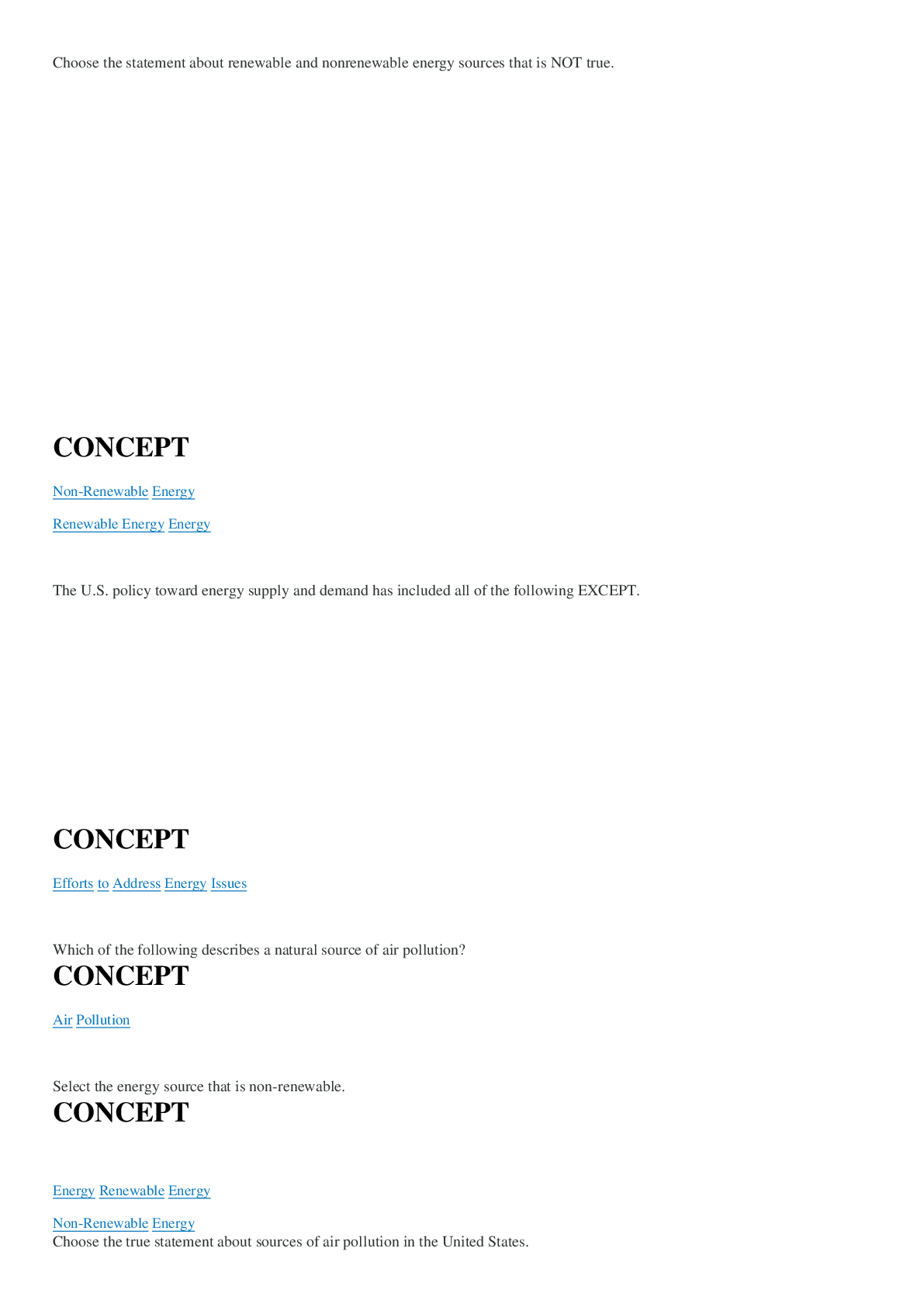
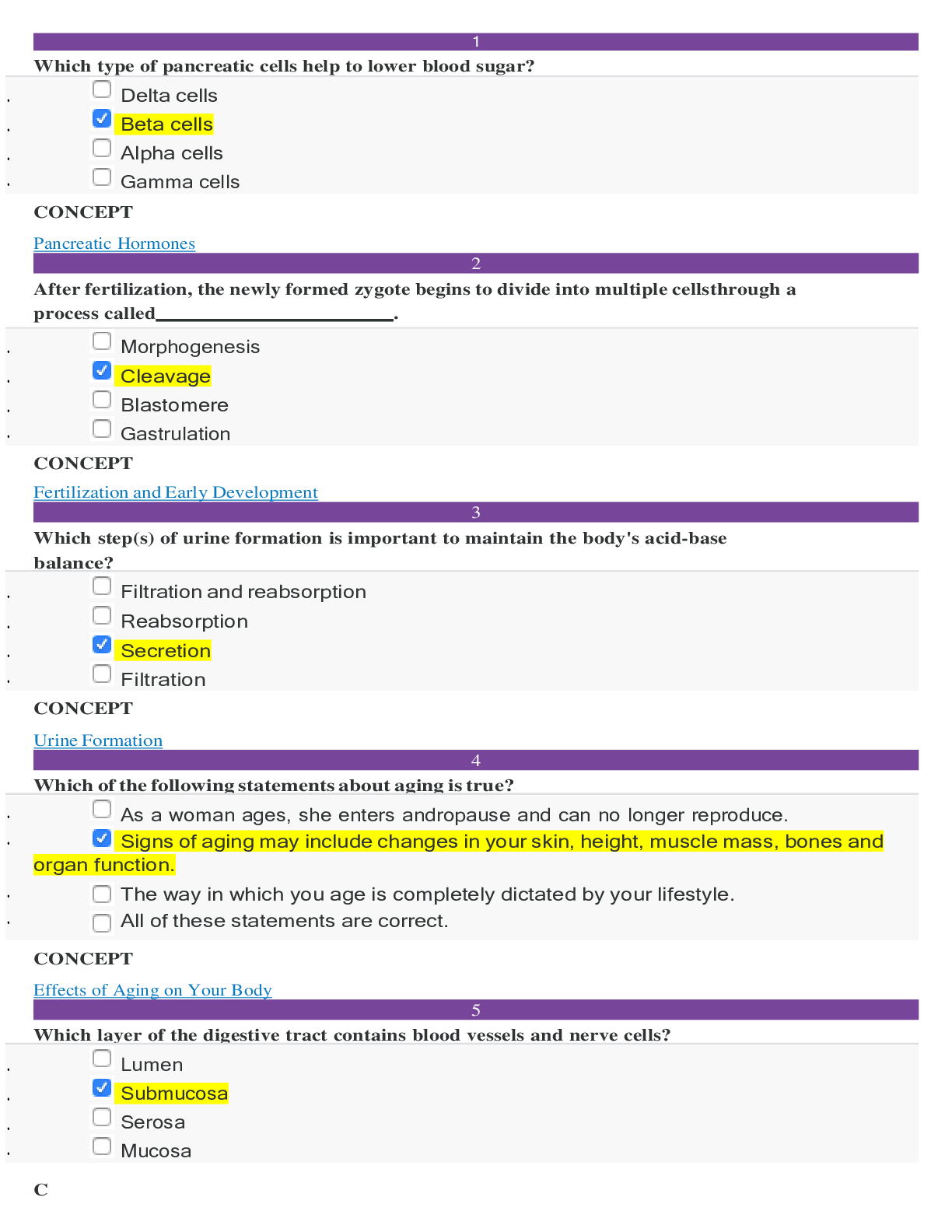
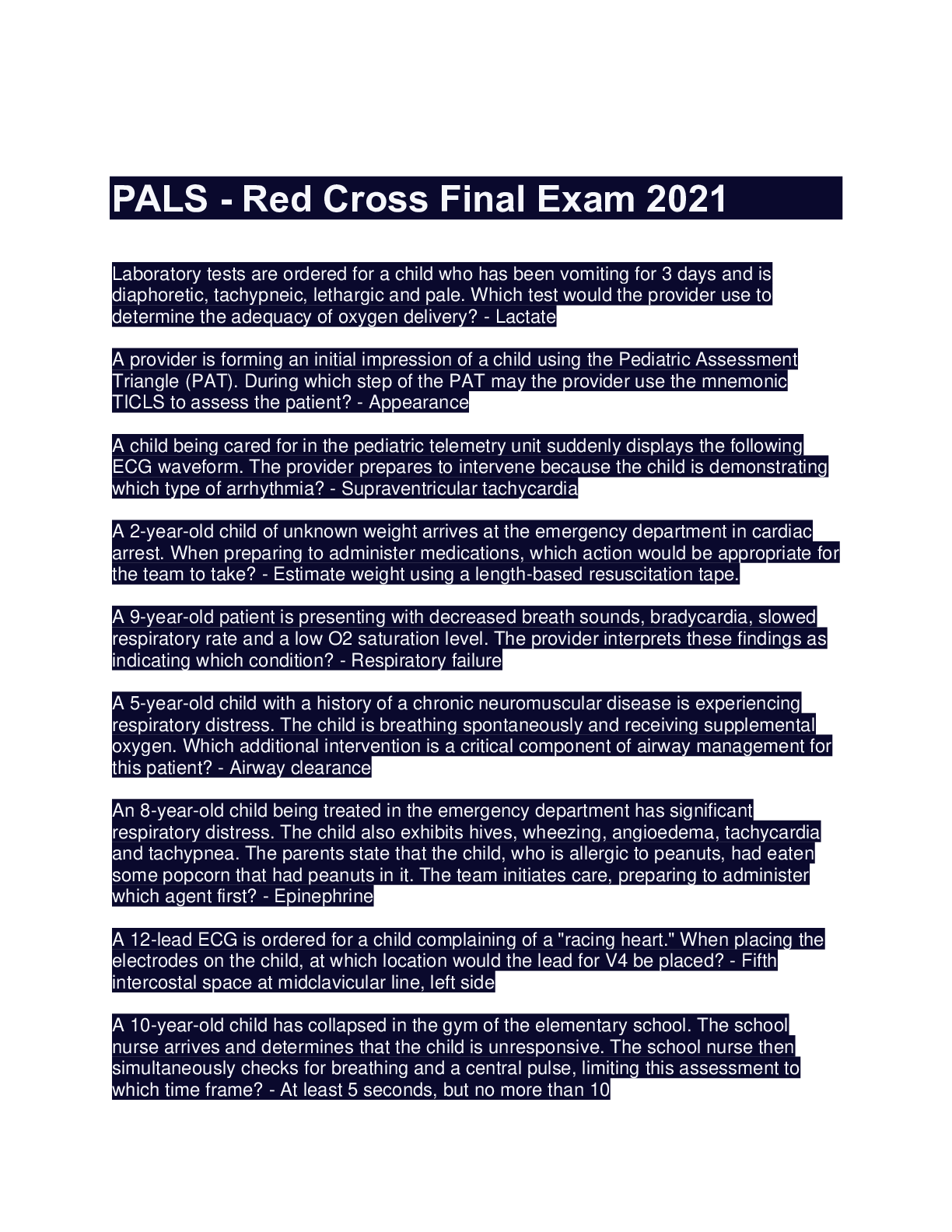


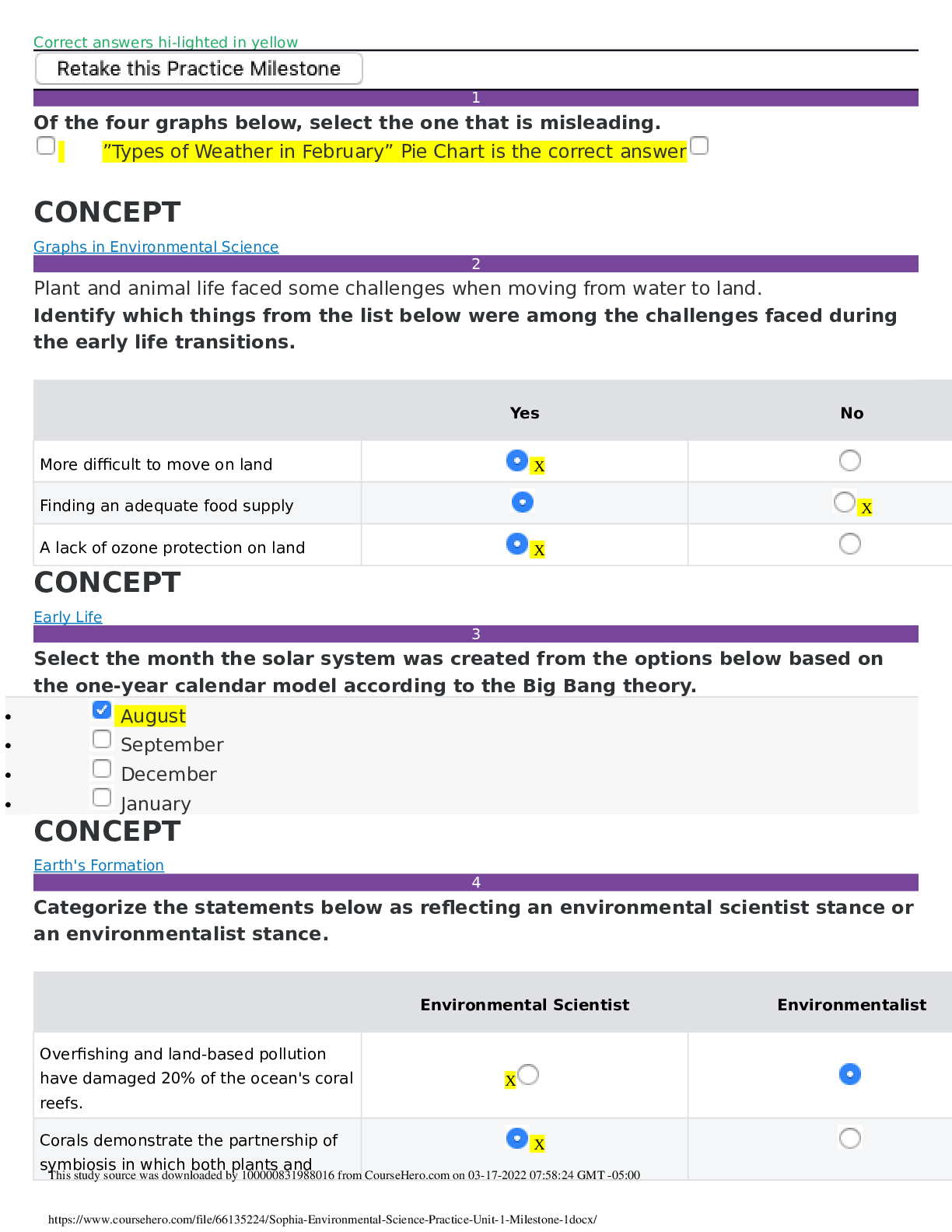
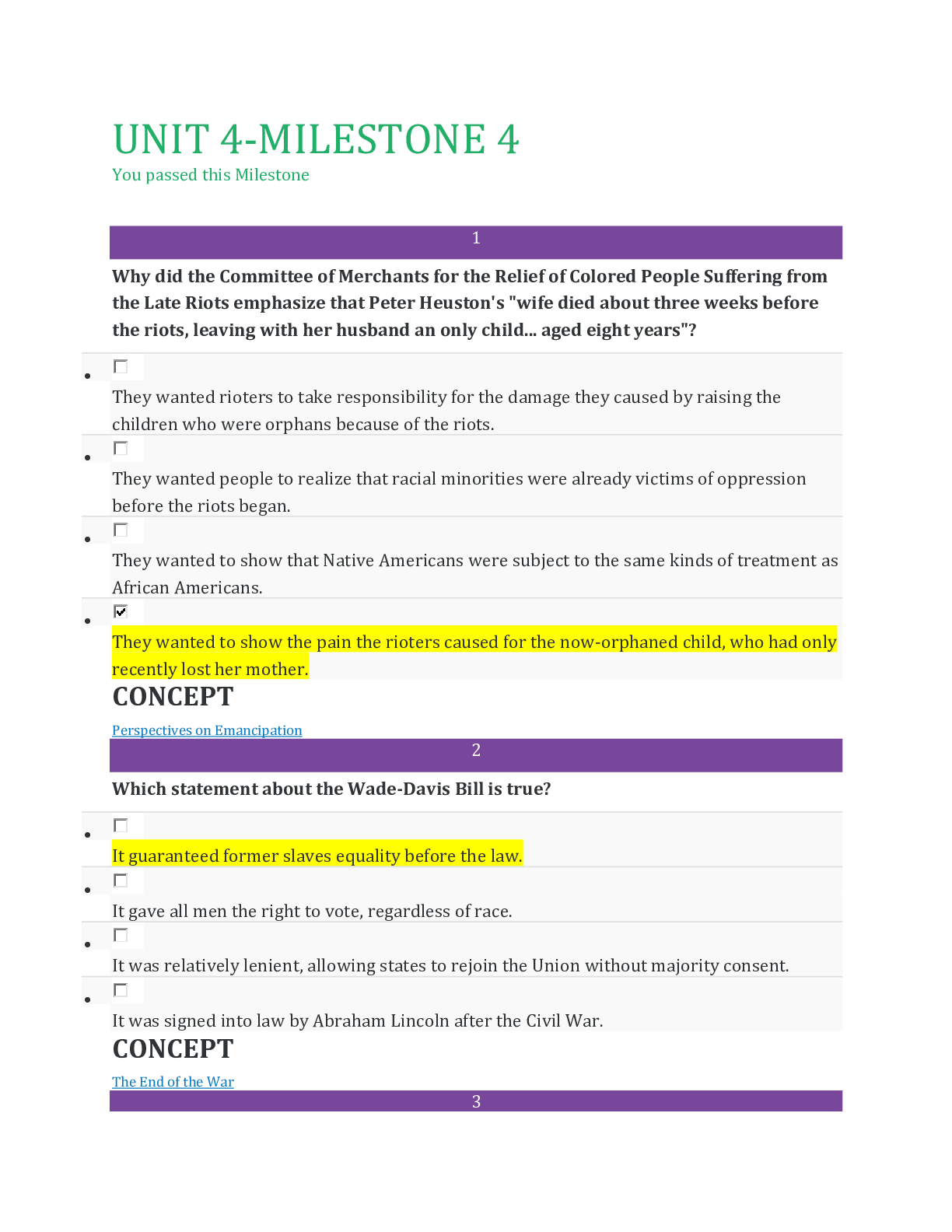
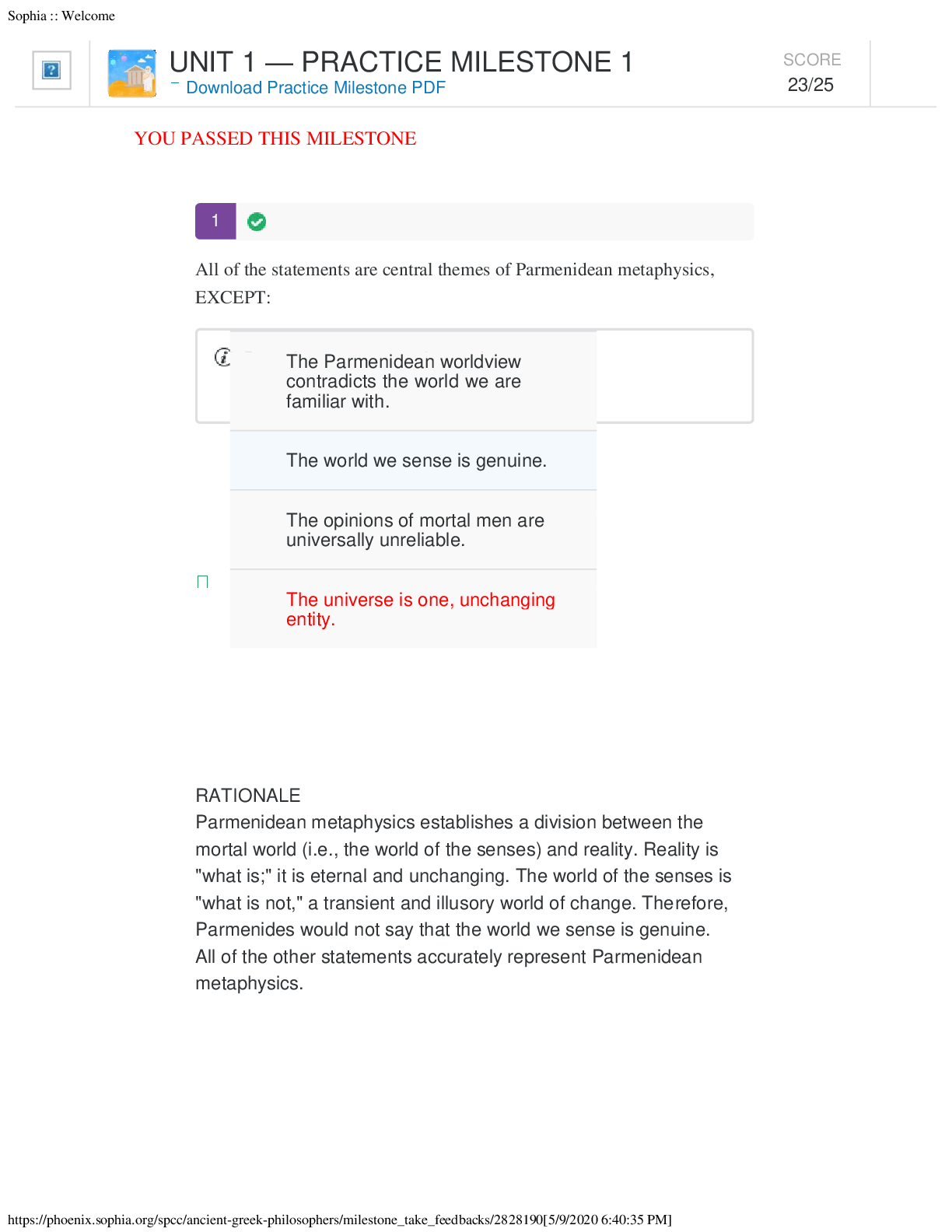
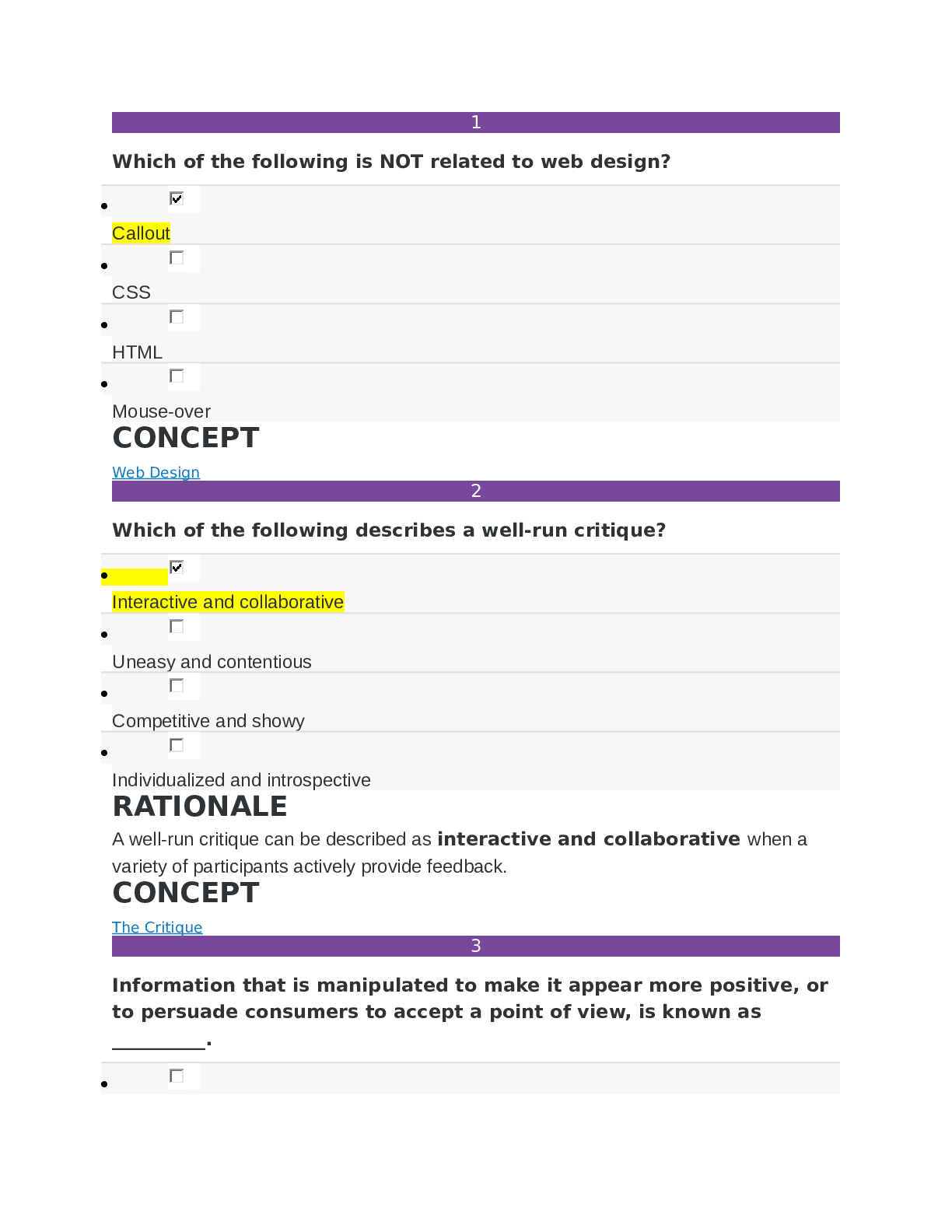
.png)
